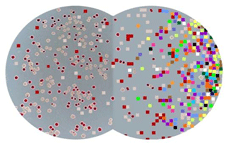Overview of the E. coli long-term evolution experiment

Click here to see a timeline
The inexorable rhythm of the project is as follows:
- Every day, the cultures are propagated;
- Every 75 days (500 generations), mixed-population samples are frozen away; and
- Mean fitness, relative to the ancestor, is estimated using the mixed-population samples.
Note that "3" can be done anytime after "2". Each of these tasks is described in detail below.
For all aspects of this project, unless otherwise stated, the following standards are maintained:
- The liquid culture medium is DM supplemented with 25 mg/l of glucose;
- Cells are spread on TA plates; and
- Liquid cultures and agar plates are incubated at 37C.
Two types of back-ups for the long-term populations are available in the event of a mishap:
- After each daily transfer, cultures are saved in the refrigerator for one day; and
- The mixed-population samples are stored indefinitely and can be used to re-start the cultures.
1. Daily transfers
- Daily transfers should be made 22-26 hours after the previous day's transfer.
- Label 12 flasks as A+1 through A+6 and A-1 through A-6. (Check flasks and beaker tops for cracks.) Add 9.9 ml of DM25 to each flask.
- Remove 12 flasks from shaking incubator. Visually confirm (slight) turbidity of each.
- Propagate 12 cultures by transferring 0.1 ml from previous day's cultures into fresh DM25. While transferring, strictly alternate between + and - cultures. This maximizes our ability to detect any inadvertent cross-contamination.
- Incubate the new flasks in the shaking incubator at 37C and 120 rpm.
- Save the old flasks for one day in the refrigerator, discarding the previous day's flasks. (In the event that a flask has cracked, or some other mishap, use the previous day's flasks from the refrigerator, setting the transfer number back by one day.)
- Be sure to record each day in the notebook by day number.
2. Storing mixed-population samples
- Every 75th day ( = 500 generations), the evolving populations are themselves stored away in the ultra-low freezer at -80C.
- Perform the daily transfer as always. Also, plate for colonies to check for contamination.
- Number and label 12 large and 12 small freezer vials. Numbering should begin after the last number used for the entire freezer collection. The large and small freezer vials receive duplicate numbering; the small vials provide back-ups. In addition to putting number stickers on top, use a blue marker to write numbers and strain identifiers on the vials. Record the strain numbers and identifications in the lab notebook, noting in particular that these are "mixed-population samples" (not clonal isolates).
- To each of the previous day's cultures, add glycerol (about 1 ml) from the small tubes. Swirl to mix the glycerol well with the culture; this takes some effort owing to the viscous nature of the glycerol.
- Using an individually wrapped, sterile bulb-pipette for each culture, transfer 1 ml to the appropriate small vial and 5 ml to the corresponding large vial. The vials are then stored away in the appropriate freezer boxes.
